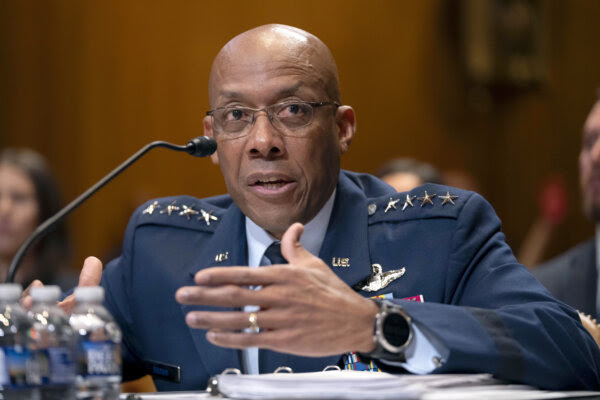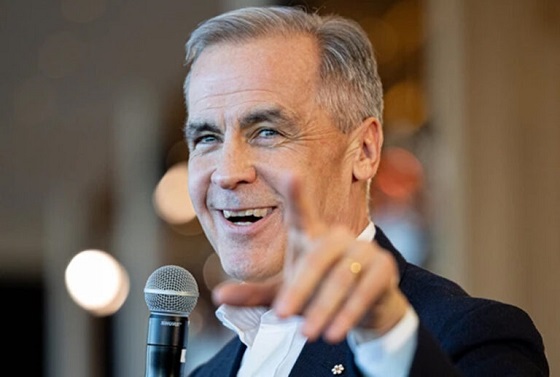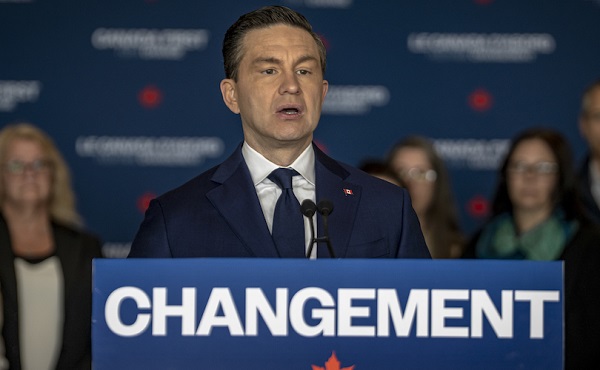armed forces
Federal government “not serious about defence,” warn Canadian military leaders

From the Macdonald Laurier Institute
J.L. Granatstein for Inside Policy
“The current prime minister of Canada is not serious about defence. Full stop. A large number of his Cabinet members are not serious about defence. Full stop.”
The Communist regime in China ramps up its aggression against Taiwan, while actively interfering in the political processes of Western democracies – including Canada. In Europe, Russia wages a brutal full-scale war against Ukraine, while sabre-rattling about nuclear strikes on our NATO allies. Meanwhile, Russian President Vladimir Putin’s Arctic ambitions threaten our sovereignty in the North.
With danger all around, one would think Canada’s federal government, led by Prime Minister Justin Trudeau, would be sounding the klaxon – rallying the country and steeling its citizens for looming conflicts with authoritarian regimes while bolstering our military for 21st-century warfare.
Alas, that seems to be far from the case, according to a pair of senior Canadian military leaders who warned recently about the federal government’s lack of commitment to and support of the military.
Over the course of four media reports that were published between May 12 and June 30, 2024, we heard the opinions of Lieutenant General (Ret’d) Andrew Leslie, and General Wayne Eyre, the Chief of Defence Staff who is retiring later this summer. Leslie, a former Liberal MP, was featured in the National Post on May 12 and again on June 30. As for Eyre, he appeared in an Ottawa Citizen article on June 20, and then in an end-of-term interview with the National Post on June 30 – just two days after the federal government announced the beginning of construction planning for the Royal Canadian Navy’s proposed fleet of fifteen destroyers.
Of these four articles, Leslie’s were by far the most important. The former Chief of Land Staff had retired from the Canadian Armed Forces to run for the federal Liberals in 2015. Elected to Parliament, he served four years – but then decided not to run for re-election. If Leslie was disillusioned, and he was, he kept silent in public until his National Post interviews. His remarks were extraordinarily blunt, but they seemingly failed to attract the public notice they deserved. Here in point form are some of his comments from his first interview:
- “The current prime minister of Canada is not serious about defence. Full stop. A large number of his Cabinet members are not serious about defence. Full stop.”
- “Our NATO allies are despairing. Our American friends are frustrated.”
- “[T]he Liberal government has no intention of meeting [the NATO standard of] two per cent (by 2030) and no intention of meeting 1.76 per cent [of GDP] (as promised in the April 2024 budget) because they rest confident in the smug knowledge that the Americans will always defend us.”
- “Since 2015, the Trudeau government has not spent, re-profiled, re-allocated, deferred, or lapsed $20 billion that was promised for defence. The impact of that is that ship fleets have not been replaced, aircraft are extraordinarily old, as are helicopters; the army is in a state of despair.”
These remarks from a former senior officer are, to my mind, devastating – much more so than those from Opposition politicians or academic experts. So too were the remarks Leslie offered on June 30:
- “According to the numbers I have 72% of the army’s vehicles and trailers are offline…. I think the big issue is, right now, the men and women in uniform don’t see any demonstrable proof that the federal government is actually seized of the issue of trying to get them the capabilities they need to better defend Canadians.”
- “The Liberal government sees defence spending as discretionary… They believe there’s a whole host of societal funding requirements, ranging from increases in healthcare, to day care, to children getting breakfast at school – and a bewildering array of boutique allocations of funds to cater to voter-sensitive initiatives. And defence comes after all of that.”
One area of special concern, Leslie maintained, was artillery shells, one of the many military items Ukraine needs in huge quantities. Canada, he stated, was falling down in producing them: “Canada has a tiny stockpile of 155-mm ammo…. One to two years prior to Russia’s latest invasion of Ukraine in 2022, a bunch of idiots decided to cancel the standing offer [with the two Canadian manufacturers of 155-mm artillery shells] because there was no business case for Canada to continue investing in the production of ammunition.”
Leslie ended the second interview by talking of those leaders he admired: “I had the privilege and honour to be in close proximity to three consecutive prime ministers who made the system work such that we bought tanks, artillery ammunition, small arms ammunition, helicopters, guns, armour-protective vehicles, new weapons systems, the list goes on. And those were Prime Minister [Jean] Chrétien, Prime Minister [Paul] Martin, and Prime Minister [Stephen] Harper.”
The general had been a member of the Trudeau government and had worked in drafting the Liberals’ defence platform in the 2015 election. But nothing had been done to implement it in a timely fashion. In Leslie’s list of prime ministers who took defence and national security seriously, Trudeau was notably absent.
The Ottawa Citizen article, by veteran defence reporter David Pugliese, was not a direct interview with General Eyre, but rather, a report on comments Eyre made behind closed doors in a speech to senior officers. Pugliese did not have a copy of Eyre’s speech but learned of it from an audience member.
According to Pugliese, Eyre, who only had a few weeks left as Chief of the Defence Staff, sounded almost optimistic about the Liberals’ 2024 budget that pledged $8 billion in new defence spending by 2030 and $73 billion more over twenty years.
Eyre reportedly told the officers, “Yeah, this policy was not as fast as we wanted it to be. And it did not give us everything we needed. But I will tell you it’s more than I expected, much more than I expected…. The prime minister told me that defence spending is only going in one direction and that is up.”
The general also reportedly spoke of creating a small team to work out an implementation plan for the new defence policy initiatives, and that he wanted some “quick hits… I see ammunition production as one of those quick hits that we absolutely have to get on with.”
In his interview with the National Post on June 20, Eyre was at times both pessimistic and positive in his assessment of the Canadian military: “[The world has entered a] pre-wartime security environment… If you’re in uniform, you learn to be pessimistic about the security situation because you’re trained for the worst case… Given the indicators and the trends that we see, I am pessimistic about the security situation…. Is this a 1938 moment? Is this a 1912 moment? The world has seen this before, with ebbs and flows, and we’re back in a multi-polar dangerous moment where the structures that have kept us generally at peace are fraying.”
If Eyre is right, Canada should be preparing for a war that is certain to affect Canada and its allies. But the Canadian procurement system for munitions and equipment is broken – a fact that Eyre freely acknowledges: “We are applying peacetime processes and peacetime mentalities to what could be considered a wartime or immediate pre-wartime security environment. So, what did we do in 1939? What did we do in 1914? We certainly didn’t take 10 or 15 or 20 years to get capabilities in place, because the war would be over by that point…. We have to deliver, and we have to deliver fast.”
The Chief of Defence Staff then spoke optimistically about Canada’s role in Latvia, where the Canadian Armed Forces leads the NATO brigade stationed there, and where the commitment is supposed to be increased in the next few years.
“We are very well respected in that part of the world,” Eyre said. “Do they want more of us? Yeah, absolutely, but for me it drives home that we produce a pretty good product…. [Canada] has and can do so much on the world stage. Compared to the majority of countries out there, we have got so much going for us.”
On June 28, 2024, Minister of National Defence Bill Blair and Angus Topshee, the Chief of the Naval Staff, announced the government’s plans to replace Canada’s Halifax-class frigates. Fifteen new destroyers would be constructed at the government’s estimate of $56 billion to $60 billion, Blair said. The Parliamentary Budget Officer earlier had estimated the construction cost at $84 billion with a “life-cycle” cost to operate and maintain the vessels at $306 billion. In reality, Blair’s announcement was not for the beginning of construction of the ships but only for a “test module.”
Some background is needed here. The Harper Conservative government in 2010 approved the National Shipbuilding Program, but it was not until 2018 that the Trudeau government, in power for three years, selected the as yet (and still) unproven British Type 26 ship as its choice. The vessels were to be constructed in Halifax at the Irving shipyards that first had to build the Arctic Offshore Patrol Ships, only completed this year (late and over-budget). Now in 2024, work at last can begin on the new destroyers.
The plan is that the first of the ships will be completed and ready for sea trials in 2033, 9 years from now and 23 years after the Harper government announced the shipbuilding program; presumably the first destroyer will not be deemed fully ready for service until at least 2034. (HMCS Halifax, the first of the frigates, went to sea in 1992, and by the time the first replacement is ready, Halifax will be 42 years old.)
But the planned completion of construction of all fifteen vessels will be glacial. Defence Minister Blair told Global TV on June 28 that the first nine ships would not be completed until 2040 and the remaining six not until 2050. In other words, it will take a quarter century for Irving to build fifteen ships – if it is able to maintain even that production schedule. The one certainty is that the ships will cost more to build – the rate of inflation for military construction is at least 6 percent higher than national inflation. The costs will be so high for these ships that it is all but certain that fewer than fifteen will ever be launched. Will any of the destroyers still be combat effective by 2050? That seems highly unlikely.
Remember what Eyre told the National Post: “We are applying peacetime processes and peacetime mentalities to what could be considered a wartime or immediate pre-wartime security environment…. We have to deliver, and we have to deliver fast.” And don’t forget Leslie’s damning comment: “The current prime minister of Canada is not serious about defence. Full stop. A large number of his cabinet members are not serious about defence. Full stop.”
At the July NATO summit in Washington, American leaders increased the heat on Trudeau to reach the 2-percent-of-GDP benchmark for military spending. “Welcomed @CanadianPM Trudeau to the U.S. Capitol today,” U.S. Senate Republican Leader Mitch McConnell wrote on X on July 9. “Shared values and close economic ties have always been the strength of the U.S.-Canada relationship. But it’s time for our northern ally to invest seriously in the hard power required to help preserve prosperity and security across NATO.”
The Trudeau government will be long gone by the time the first of the new destroyers puts to sea, and it will be completely forgotten by the time the last one sets sail. We must hope that no war intervenes in the next quarter-century because Canada certainly will not be ready – and not only with its navy. “Not serious about defence”– let’s hope we will not pay a high price for the neglect of this country’s most vital national interest.
J.L. Granatstein taught Canadian history, was Director and CEO of the Canadian War Museum, and writes on military and political history. A member of MLI’s Research Advisory Board, Granatstein’s most recent book is Canada’s Army: Waging War and Keeping the Peace. (3rd edition).
armed forces
Canada’s Military is Collapsing. Without Urgent Action, We Won’t Be Able To Defend Ourselves

From the Frontier Centre for Public Policy
By David Leis
Decades of underfunding and political neglect have left our military weak and unprepared
What Lt.-Gen (retired) Michel Maisonneuve (ret.) told me about Canada’s military was nothing short of alarming. He didn’t mince words—our armed forces are in dire straits. If we don’t act now, Canada will not only be unable to defend itself, but it will cease to be taken seriously by our allies, many of whom are already losing patience with our military decline.
Maisonneuve has seen firsthand what a functioning military looks like. He has served at the highest levels, working alongside our allies in NATO, and he knows exactly what Canada is failing to do. “We are no longer at the table when major defence decisions are made,” he told me. “The Americans don’t ask us what we think anymore because they know we can’t contribute.” That is a stunning indictment of where we now stand—a country that was once respected for its ability to punch above its weight militarily has been reduced to an afterthought.
The problem, as Maisonneuve laid out, is both simple and staggering: Canada doesn’t take its defence seriously anymore. The government has allowed our forces to wither. The Air Force is still buying CF-18s from the 1980s because the long-delayed F-35 procurement is years behind schedule. The Navy, once a competent maritime force, is barely functional, with no operational submarines and a fleet that is nowhere near what is needed to patrol our vast coastlines.
Meanwhile, the Army is struggling to recruit and retain soldiers, leaving its numbers dangerously low. “We have an Army in name only,” Maisonneuve said. “If we were called upon tomorrow to deploy a fully operational combat force, we couldn’t do it.”
Even more shocking is the state of readiness of our troops. A recent report found that 75 per cent of Canadian military personnel are overweight. Maisonneuve didn’t sugarcoat it:
“It’s unacceptable. We are supposed to be training warriors, not watching fitness standards collapse.” When the people entrusted with defending our country are struggling with basic physical fitness, it speaks to something much deeper—an institutional rot that has infected the entire system. Our allies have noticed. Canada was locked out of AUKUS, the military alliance between the U.S., the U.K. and Australia. “It wasn’t an oversight,” Maisonneuve explained. “It was a deliberate snub. The Americans don’t see us as a serious defence partner anymore.” That snub should have been a wake-up call. Instead, our government shrugged it off.
Meanwhile, Washington is openly questioning Canada’s value in NATO. The Americans see the numbers—Canada refuses to meet even the minimum defence spending requirement of two per cent of GDP. Instead of fulfilling our obligations, we offer up empty promises and expect others to pick up the slack.
Maisonneuve is blunt about what needs to be done. “First, we need to fully fund the military—and that means not just hitting the NATO target but exceeding it. Our allies spend real money on their defence because they understand that security is not optional.” He suggests Canada should aim for at least 2.5 per cent of GDP, not just as a show of commitment but as a necessity to rebuild our capabilities. Beyond money, Maisonneuve argues that military culture must be restored.
“We’ve allowed ideology to creep into the ranks. The military’s primary function is to defend the nation, not to serve as a social experiment,” he said. “We need to get back to training warriors, not worrying about whether we’re ticking the right diversity boxes.” He believes a return to a warrior ethos is essential— without it, the military will remain directionless.
Procurement is another disaster that Maisonneuve insists must be fixed immediately. “We’ve spent years dithering on replacing equipment, and every delay puts us further behind,” he said. The F-35 deal should have been signed years ago, but political hesitation means we won’t see a full fleet for years. The Navy urgently needs new submarines and icebreakers, especially to secure the Arctic, where other global powers, particularly Russia, are ramping up their presence.
The biggest issue, though, is manpower. “We need to rebuild the forces, period,” Maisonneuve told me. “That means recruiting, training, and retaining soldiers, and we are failing at all three.” He even suggested that Canada should consider implementing a national service requirement, a move that would not only increase troop numbers but also instill a sense of duty and responsibility in younger generations. “We used to be a country that took security seriously,” he said. “What happened?”
That’s the question, isn’t it? What happened to Canada? How did we go from being a country that contributed meaningfully to global security to one that can’t even defend itself? The reality is that successive governments have let this happen—first by neglecting funding, then by letting bureaucracy suffocate procurement, and finally by allowing the core purpose of the military to be diluted.
Maisonneuve is clear: Canada must act now, or it will cease to be taken seriously.
David Leis is President and CEO of the Frontier Centre for Public Policy and host of the Leaders on the Frontier podcast
armed forces
Trump fires chairman of Joint Chiefs of Staff, appoints new military leader


From the Daily Caller News Foundation
By Mariane Angela
President Donald Trump announced Friday the dismissal of General Charles Brown, the current Chairman of the Joint Chiefs of Staff.
In a post on Truth Social, Trump expressed his gratitude toward Brown for his extensive contributions and leadership, wishing him and his family a prosperous future. Brown’s departure marks a pivotal moment in U.S. military leadership following over 40 years of service.
“I want to thank General Charles “CQ” Brown for his over 40 years of service to our country, including as our current Chairman of the Joint Chiefs of Staff. He is a fine gentleman and an outstanding leader, and I wish a great future for him and his family,” Trump wrote.
Simultaneously, Trump introduced his nominee for Brown’s successor.
“Today, I am honored to announce that I am nominating Air Force Lieutenant General Dan “Razin” Caine to be the next Chairman of the Joint Chiefs of Staff. General Caine is an accomplished pilot, national security expert, successful entrepreneur, and a “warfighter” with significant interagency and special operations experience,” Trump said.
Trump said Caine’s appointment comes after he was overlooked for advancement during former President Joe Biden’s presidency.
“General Caine was passed over for promotion by Sleepy Joe Biden. But not anymore! Alongside Secretary Pete Hegseth, General Caine and our military will restore peace through strength, put America First, and rebuild our military,” Trump said. President Trump also announced plans to appoint five additional senior military officials, tasks he has delegated to Secretary Hegseth.
It was reported Thursday that Hegseth plans to dismiss Brown as part of President Trump’s commitment to eliminate “wokeness” from the military. Brown reportedly appears on a list of proposed removals submitted to Congress.
Brown had previously expressed his wish to retain his position even after Trump took office, and according to sources speaking to NBC News in Dec. 2024, Trump seemingly moderated his views on the general. Biden nominated Brown as chairman in 2023, and despite a heated confirmation hearing where senators scrutinized his alleged implementation of racial quotas in Air Force hiring practices, he was confirmed.
Meanwhile, Brown’s replacement, Caine, took office as the associate director for Military Affairs at the CIA on Nov. 3, 2021, after serving as the director of Special Programs at the Pentagon. Lt. Gen. Dan Caine, an F-16 pilot with extensive experience including over 150 combat hours, was commissioned in 1990 and has held numerous key roles, from the White House staff to special operations, and balances his military career with entrepreneurial ventures.
-

 2025 Federal Election1 day ago
2025 Federal Election1 day agoTrump Has Driven Canadians Crazy. This Is How Crazy.
-

 2025 Federal Election2 days ago
2025 Federal Election2 days agoCarney’s Hidden Climate Finance Agenda
-

 2025 Federal Election1 day ago
2025 Federal Election1 day agoThe Anhui Convergence: Chinese United Front Network Surfaces in Australian and Canadian Elections
-

 Automotive14 hours ago
Automotive14 hours agoHyundai moves SUV production to U.S.
-

 2025 Federal Election1 day ago
2025 Federal Election1 day agoStudy links B.C.’s drug policies to more overdoses, but researchers urge caution
-

 2025 Federal Election2 days ago
2025 Federal Election2 days agoConservatives promise to ban firing of Canadian federal workers based on COVID jab status
-

 International2 days ago
International2 days agoPope Francis Got Canadian History Wrong
-

 2025 Federal Election2 days ago
2025 Federal Election2 days agoWhen it comes to pipelines, Carney’s words flow both ways



